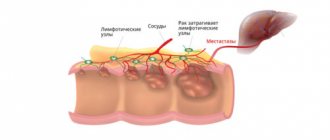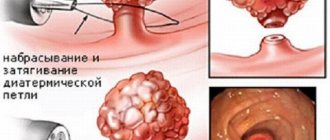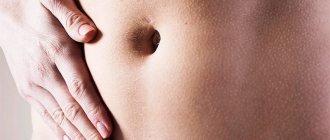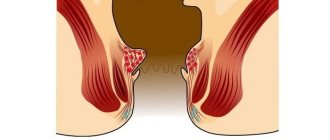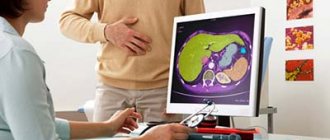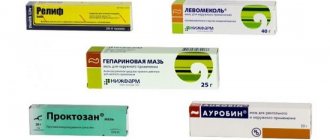- Causes of male hemorrhoids
- What are hemorrhoids?
- Symptoms of hemorrhoids in men
- Stages of the disease
- Why are hemorrhoids dangerous?
- Diagnosis of hemorrhoids
- Treatment of hemorrhoids in men
- Surgical methods for removing hemorrhoids
- Complications after surgery
- Prevention of hemorrhoids
Hemorrhoids are one of the weaknesses of the stronger sex. According to medical statistics, men are 3 times more susceptible to this disease than women. But the root of evil is not in the physiological characteristics of the female and male body. Rather, male carelessness is to blame. To be convinced of this, it is enough to familiarize yourself with the list of the main causes of hemorrhoids in men.
Causes of male hemorrhoids
Hemorrhoids are inflammation, pathological expansion of venous vessels in the anus. The following are the causes of hemorrhoids in men:
- Alcohol and smoking . The toxic chemicals contained in alcohol cause a sharp rush of blood to the pelvic area. The regularity of “impacts” on the walls of the veins negatively affects their condition.
- Poor nutrition . Most men “lean” on meat products, being rather dismissive of vegetables, fruits, and cereals. Another “male” feature is the abuse of spicy food. Firstly, it’s delicious, and secondly, it is believed that some spices improve potency. Food rich in seasonings but low in fiber slows down intestinal motility (motility), constipation appears, causing the formation of hemorrhoids.
- Digestive system disorders, infections . Diarrhea, constipation, intestinal disorders, stomach disorders, colitis, etc.
- Overweight . The connection between susceptibility to disease and obesity has been scientifically proven.
- Lifting weights . Historically, hard physical labor was the domain of men. Lifting heavy objects causes tension in the sphincter (ring muscle) of the anus. Systematic exercise on weight machines without medical supervision is also dangerous.
- Sedentary work . Drivers, engineers, operators, computer scientists, and managers of many companies are mostly men. As a result of being in a sedentary, sedentary state for several hours - driving a car, writing a desk - the blood flow in the pelvic organs “freezes”. No less dangerous is standing on your feet for many hours - security guards, teachers, hairdressers, salespeople.
- Inflammatory processes . Next to the rectum in men is the bladder and prostate gland. Inflammation in these organs can cause venous stagnation.
- Heredity . An 80% chance of hemorrhoids occurring is ensured by the presence of the disease in relatives - father, grandfather.
- Physical defects . Age-related changes, absence of valves in hemorrhoidal veins and other developmental defects.
- Anal sex . Irritation of the rectal mucosa, stretching of the anal sphincter, and mechanical damage become the direct cause of the occurrence or exacerbation of inflammatory processes.
Hemorrhoids can be the result of cirrhosis of the liver, a neoplasm in the abdominal cavity or a tumor in the pelvic area, persistent coughing due to bronchitis, and even the use of cruel toilet paper.
Doctors also believe that chronic stress can cause hemorrhoids, and there is some truth in the jokes: men are the “weaker sex.” According to research by psychologists at the Spanish University of Granada, men are more likely to experience strong anger, contempt and other negative emotions.
Typically, the first signs of the disease appear in men in middle and adulthood. The causes of hemorrhoids in young men and boys are more often physical developmental defects, hereditary factors, and training on weight training equipment.
Hemorrhoids: types, stages
The causes, symptoms, and treatment of the pathology will be presented to you below. Before this, it is worth giving a description of the disease itself, as well as talking about its main forms and types.
Hemorrhoids are formations that are located on the walls of the rectum. It appears due to defects in the intestinal walls, as well as disruption of the blood vessels. As hemorrhoids progress, the vein walls expand greatly, and the blood stagnates and thickens. Subsequently, the inflammatory process begins. According to its location, the hemorrhoidal node can be internal or external. Education also has 4 main stages:
- 1 – nodes are small in size and practically do not manifest themselves;
- 2 – the first signs of hemorrhoids are determined, the inflammatory process begins;
- 3 – the nodes do not adjust on their own after they fall out, but you can return them to their place with your hands;
- 4 – there is no way to set the fallen nodes, a strong inflammatory process progresses, palpation turns out to be unbearably painful.
In addition to the types described, hemorrhoids can be congenital or acquired. The second type of pathology occurs in 80 percent of all cases. Also, acquired hemorrhoids can be an independent disease or a consequence of another pathology.
What are hemorrhoids?
The first mention of the term “hemorrhoids” is found in the writings of Hippocrates. Haimorrhoi's (Greek) - bleeding.
In the walls of the rectum there is a mass of venous vessels that form dense plexuses. When blood flow stagnates and elasticity deteriorates, their walls stretch and bulge—this is a hemorrhoid. In practice, hemorrhoids are varicose veins of the rectum in the anus.
Depending on the location of hemorrhoids, two types of disease are distinguished:
- Internal . Hemorrhoids are located above the rectal-anal line - under the rectal mucosa.
- Outdoor . The nodes are located below the rectal-anal line - under the skin.
It is possible for a patient to have two types of hemorrhoids at the same time.
Treatment
Depending on how hemorrhoids manifest in men, several methods of treating this disorder may be prescribed - taking medications or medical intervention. The use of any folk remedy for hemorrhoids in men is excluded.
The first method consists of prescribing medications to the patient aimed at preventing the formation of blood clots, stopping hemorrhages, having an antiviral effect, and relieving pain. The latter substances are often used in the form of ointments, gels or suppositories. In addition, conservative therapy involves taking a vitamin complex, laxatives, and following a diet.
Surgical treatment of hemorrhoids in men involves one of the following interventions:
- sclerotherapy - injection of drugs into hemorrhoids;
- coagulation with infrared radiation - stopping bleeding under the influence of heat;
- ligation with latex rings;
- removal of nodes using laser radiation;
- suturing of arteries above the location of hemorrhoids.
Such principles of therapy are applicable at the initial, middle and moderate stages of the disease. In case of severe hemorrhoids, as well as in the presence of complications, the following methods are provided:
- surgical removal of nodes and affected tissues, after which plastic surgery is performed to restore the anal canal;
- resection of the pathological part of the rectum.
In some cases, doctors recommend combined treatment using conservative and surgical methods.
Symptoms of hemorrhoids in men
The danger of the disease lies in the mild nature of the symptoms. Developing gradually, it does not cause much concern in a man.
- Itching, slight pain, burning in the anus are evidence of erosion of the walls of the venous vessels. Often mistaken for signs of parasites.
- Small lumps and lumps around the anus are symptoms of external hemorrhoids.
- Sensation of a foreign body in the anus, heaviness in the groin area. Such symptoms appear in the presence of blood-filled hemorrhoids.
- The presence of blood in stool, on toilet paper, and sometimes underwear is the main sign of hemorrhoids. This can range from small drops to intense bleeding during or after bowel movements.
- Venous node prolapse. The cause may be constipation and straining during an attack of diarrhea, prolonged sitting on the toilet - reading, smoking. Subsequently, prolapse of hemorrhoids may occur during physical exertion, severe coughing or sneezing.
- Pain in the anal area when defecating, sitting, walking. Attacks of unbearable pain can occur even at night at rest for no apparent reason - a sign of the acute stage of the disease.
Symptoms are often intermittent. Sometimes there comes a period of calm and the illusion is created that the problem has “resolved.” But the disease continues to develop internally and the impact of any unfavorable factor is sufficient for external manifestation.
If any of these symptoms appear, you should consult a proctologist. But men try to bypass this specialist’s office first. As a result, the disease progresses.
First signs
The initial stage of hemorrhoids in men often goes unnoticed and can last for years.
The obvious first signs of hemorrhoids are:
- A feeling of a foreign object in the anus that does not go away after bowel movement.
- Feeling of incomplete bowel movement.
- Itching or tingling in the sphincter area.
- Perianal dermatitis (irritation of the skin around the sphincter).
The above initial symptoms are symptoms of internal hemorrhoids, which may not attract attention due to their extremely rare and fleeting manifestations.
Over time, the symptoms become more regular and begin to cause concern.
How else do hemorrhoids manifest?
Common symptoms of hemorrhoids in men are as follows:
- Bleeding after defecation.
- Prolapse of hemorrhoids.
- Blood clots in stool.
- Tingling sensations while going to the toilet.
- Painful bowel movement.
It is not necessary that you have all these signs, but the presence of at least 1 or 2 is a reason to get checked by a doctor.
Stages of the disease
From the onset of the first symptoms to serious clinical manifestations of hemorrhoids, several months or several years may pass.
First stage
The initial stage of the disease occurs without serious exacerbations and does not cause concern in men. Small nodes located inside are invisible, and the emerging bumps of external nodes do not attract attention. Signs of the first stage are discomfort in the anus (wetness, itching), blood on toilet paper.
Second stage
As hemorrhoids grow, the pain increases. Constant irritation of the skin of the anus with inflammatory fluid leaking from the intestine increases the burning and itching. Pain and sensation of a foreign body appear in the rectum. Bleeding is accompanied by almost every bowel movement, and the blood can even flow in a trickle.
It is possible for hemorrhoids to prolapse outwards, but after defecation they usually go inside on their own.
Third stage
The persistence and intensification of the symptoms of the second stage is complemented by a number of complications:
- prolapse of nodes during physical activity;
- prolapsed nodes do not correct themselves;
- thrombosis or strangulation of the node is possible.
In the latter case, surgery may be required.
Fourth stage
Incessant itching, burning in the anus, constant pain. It is impossible to reduce hemorrhoids; all acts of defecation are accompanied by severe bleeding. The result of infection on the wounds is the beginning of purulent processes.
Another “male” feature is delaying visits to the medical office as much as possible. Representatives of the stronger sex are more afraid and embarrassed by doctors than women. Therefore, they seek help when “it can’t get any worse.”
Varieties
Types of hemorrhoids
Depending on the location of hemorrhoids in men, there are:
- internal - an increase in hemorrhoids is observed under the mucous membrane of the rectum or under the skin of the anus. Their loss during this course is observed in half of all cases. In such a situation, the doctor prescribes rectal suppositories for treatment;
- external – characterized by the formation of blood clots and the formation of a skin fold around the anus;
- combined – specific characteristics of the two above forms are expressed;
- with the formation of an anal fissure.
There is also a classification based on the intensity of expression of various symptoms:
- initial - a small amount of blood is observed in the stool. The nodes do not fall out;
- moderate severity - in addition to hemorrhage, prolapse of hemorrhoids during emptying is observed, after which they are reduced on their own;
- severe - the nodes bleed, fall out, but do not reset on their own. Prolapse is observed not only during defecation, but also during any other process that increases intra-abdominal pressure;
- complicated - the above symptoms are observed, the entire anal area is involved in the pathological process, blood clots form, which can lead to an attack of acute hemorrhoids.
Why are hemorrhoids dangerous?
Even at the end of the last century, the bulk of the population attached no more importance to hemorrhoids than to an ordinary splinter. The opinion of many modern men about this disease remains at this level. But in addition to discomfort and pain, hemorrhoids can cause other complications.
- Anemia is the result of constant blood loss.
- Anal fissure. It can cause an abscess and can only be treated surgically.
- Itching undermines a man’s psycho-emotional state. In addition, regular mechanical irritation and tissue damage to the anus increases the risk of developing inflammatory and tumor processes.
- Insufficiency of the anal sphincter - incontinence of feces and gases.
- Inflammation of surrounding tissues - the development of purulent inflammation of the rectum (paraproctitis).
- Thrombosis of hemorrhoids often causes necrosis (death), which poses a danger to a man’s life.
Early diagnosis makes it possible to solve the problem of hemorrhoids and prevent its complications.
What is the danger of hemorrhoids?
Men often underestimate the danger of developing hemorrhoids. And often, due to embarrassment, they consult a doctor with this delicate problem in the later stages of the disease, when the pathology has already led to bleeding. Although in the initial stage hemorrhoids are much easier to cure.
An advanced disease becomes a reason for the development of anemia due to prolonged bleeding, sometimes requiring immediate hospitalization followed by surgical treatment.
A serious consequence of hemorrhoids is thrombosis in the area of the nodes, which threatens the development of necrosis, which is often treated only with surgery. Another complication can be considered paraproctitis, which is a purulent inflammation of adjacent tissues.
In the absence of timely treatment, a fistula may form, which will lead to infection in the abdominal cavity and retroperitoneal space. In addition, hemorrhoids are dangerous due to the development of extensive swelling and the appearance of purulent discharge.
Important! According to official data, hemorrhoids can become one of the causes of cancer in the groin area. That is why you should not delay contacting a specialist for appropriate therapy.
Diagnosis of hemorrhoids
The diagnosis of hemorrhoids can be made by a doctor based on a patient interview. In order to obtain a clearer description of the disease and exclude other pathologies of the rectum that have symptoms similar to hemorrhoids, additional studies are being conducted.
Finger examination
Based on the digital examination, the proctologist prescribes treatment or further diagnostic measures.
Anoscopy
The study is carried out using a special instrument - an anoscope and allows you to examine the rectum to a depth of 14 cm from the anus.
Rectoscopy
A rectoscope is a special small-diameter tube with lighting elements and an optical system. Modern models are equipped with a video camera that transmits the image to the monitor. According to the indications and presumptive diagnosis, a rigid (rigid) or flexible proctoscope is selected. The instrument allows you to examine the rectum to a depth of 35 cm and examine the overlying sections of the intestine up to the cecum.
Irrigoscopy
For X-ray examination, the large intestine is filled with a barium mixture (contrast agent).
Laboratory research
The characteristics of feces and blood are studied. It is possible to conduct DNA diagnostics to determine a man’s predisposition to cancer.
Complications
If you try to fix the problem on your own and if you see a doctor late, there is a high probability of developing severe complications. The consequences of hemorrhoids in men are:
- hemorrhages from the rectum. At the initial stages of development of the disorder, not much blood is released, but as it progresses, an increase in blood secretion is observed. If at first this can be eliminated with the help of rectal suppositories, then in severe cases hospitalization of the patient is necessary;
- paraproctitis – purulent inflammation of the affected tissues;
- a decrease in the number of red blood cells can cause anemia;
- pinching of the hemorrhoid;
- formation of cracks in the rectum;
- cryptitis and fistulas;
- pelvic gangrene, gas in nature. The complication is difficult to respond to any treatment;
- transformation of a fistula into an oncological tumor.
Proper prevention of hemorrhoids in men will avoid the development of pathology and complications.
Treatment of hemorrhoids in men
Complete healing from hemorrhoids can only be guaranteed by an integrated approach - lifestyle changes, following doctor’s prescriptions. The result of self-treatment of the disease is its transition to the next stage.
Treatment of the first stage
When contacting a proctologist at the first stage of the disease, the doctor usually recommends making lifestyle changes, prescribing rectal suppositories, and the simultaneous use of traditional medicine techniques.
Treatment of the second stage
In addition to the previous methods, minimally invasive techniques are used:
- Sclerotherapy. Drugs that glue them together are injected into the vessels.
- Cryotherapy. The nodes are frozen with liquid nitrogen, and after they die, a small wound remains.
- Electrocoagulation. Hemorrhoids are exposed to low voltage current.
- Laser coagulation. Carbon dioxide or neodymium lasers are used.
- Photocoagulation - blood flow to the venous node is blocked by a thermal energy flow.
Latex rings are also placed on hemorrhoidal nodes, after a while the node disappears.
Treatment of the third stage
In addition to rectal suppositories, ointments of the same name are prescribed, since the nodes are often located outside.
Treatment of the fourth stage
The “worst case” option is treated mainly surgically—removal of the nodes.
The use of traditional medicine techniques, homeopathy, hirudotherapy, acupuncture, and acupressure can give good results. But only taking into account the recommendations of the attending proctologist, based on individual studies of the body of a particular man.
Methods of surgical treatment
In case of stage 2-4 hemorrhoids, the appearance of complications in the form of necrosis, tumors, etc., classical surgical intervention or hardware minimally invasive treatment may be required - a specific technique is chosen by a specialized proctologist based on the current state of the patient’s body, the presence of contraindications, additional pathologies , etc.
Surgical measures:
- Infrared photocoagulation . A non-invasive technique for treating affected nodes with a thermal laser. By blocking the blood flow to the site, the hemorrhoidal formation is eliminated. Used at stages 1-2 of hemorrhoids;
- Sclerotherapy . Direct injection of a number of drugs into hemorrhoids, which allows you to quickly and effectively eliminate the problem at stages 1-2 of the disease;
- Ligation of hemorrhoids . The principle of the method is to throw special “rings” on the hemorrhoids, as a result of which they “fall off” after a few sessions. An effective and low-traumatic method is applicable at stages 1-3 of the pathology;
- Dysarteriation of nodes . The procedure is carried out under ultrasound guidance and consists of ligating the arterial vessels in front of the hemorrhoids. The technique is effective at stages 2-3 of the disease;
- Hemorrhoidectomy . Classic surgery, closed or open, is used in cases of ineffectiveness of the above methods or in the terminal stages of hemorrhoids complicated by paraproctitis, necrosis, tumors and other additional pathologies.
Surgical methods for removing hemorrhoids
Classic methods of hemorrhoid removal have undergone significant changes and continue to change - new technologies and equipment. Modern medical techniques make it possible to shorten the duration of the operation, reduce the intensity of pain syndromes and reduce the postoperative rehabilitation period.
Hemorrhoidectomy
Indicated for grade 3 and 4 hemorrhoids. Excision of the rectal mucosa above the venous node, as well as the skin in the anus and adenoma is performed. The wounds are sutured or left open.
Longo method
According to the method of the Italian surgeon Antonio Longo, hemorrhoids are not excised, but only pulled up. A decrease in blood flow leads to a decrease in their size and complete drying out and overgrowth with connective tissue in the future. The method is only suitable for the treatment of internal hemorrhoids.
Hemorrhoidotomy
Classic excision of hemorrhoids, performed in a hospital setting under general anesthesia.
Any method of surgical intervention has contraindications. The minimum is:
- Weak ability of the body to heal wounds and regenerate.
- Insufficiency of the anal sphincter.
- Risk of urinary dysfunction.
- Complications in the form of paraproctitis.
The full range of contraindications is determined not by the patient’s gender, but by the surgical method used.
Complications after surgery
The postoperative period can last from several hours to several days. Depends on the method of surgical intervention, the stage of the disease, and the characteristics of the man’s body. Even minimally invasive methods for removing hemorrhoids can be accompanied by various complications.
- Rectal fistulas.
- Inflammatory processes.
- Bleeding.
- Problems with urination are a “male” complication.
- Infections of affected tissues.
- Insufficiency of the anal sphincter.
- Pain syndrome.
- Narrowing of the anal canal.
Psychological fear can provoke stool retention - also one of the consequences of surgical intervention.
Doctors recommend following a strict diet for the first 1-2 days - steamed or boiled foods are eaten in the form of warm gruel in small portions 6 times a day. Spicy, fermented milk, spicy, flour products, as well as tea, coffee, raw fruits and vegetables are excluded. And, of course, tobacco, alcohol (including beer). On day 2-3, you can switch to the usual regimen, but do not forget about the doctor’s recommendations.
Methods for treating acute and chronic hemorrhoids
The first acute attack of hemorrhoids is treated conservatively. Chronic forms of the disease are subject to surgical treatment.
In the early stages, the “softest” methods for removing hemorrhoids are indicated: • sclerotherapy (introduction of a substance into the cavity of the node that causes “gluing” of the walls of the node); • infrared coagulation (cauterization of the node leg with a heat ray); • laser surgery (laser sealing).
Minimally invasive surgery for ligating (ligating) hemorrhoids with latex rings gives good results. According to indications, such intervention is carried out at stages I – III of the disease.
At stage IV of development, the only method of getting rid of the disease is a traumatic surgical operation - hemorrhoidectomy.
Prevention of hemorrhoids
The most reliable way to maintain health is to prevent disease. Moreover, the preventive measures recommended to prevent hemorrhoids are also a means for treating it.
- Alcohol, smoking, anal sex - exclude!
- It is necessary to completely eliminate “intestinal” problems - diarrhea, constipation, flatulence. And for this you need to watch your diet - more fiber. Eating liquid food helps stabilize and soften stool. The average amount of fluid required for a man per day is from 2.5 to 3 liters.
- You should not push too hard during bowel movements. If there are problems, it is better to lubricate the anus with Vaseline, vegetable oil, and baby cream to a depth of about 2 cm. This will prevent damage to the mucous membrane and facilitate the process of bowel movements. Sitting on the toilet with a crossword puzzle or a cigarette is also not healthy.
- The best option is to wash after defecation. But if this is not possible, then you should use mild cleansers - white, unscented toilet paper, wet paper or cloth wipes.
- To soothe itching in the anal area, use ointments and creams. Don't scratch!
- Handle weight training equipment with care. If physical activity is necessary, for example, lifting a heavy object, use special devices and the help of other people.
- Limit your intake of salt, spicy foods, soda, coffee, and foods that may cause constipation or diarrhea.
- No antibiotics or other medications without a doctor’s prescription!
- More movement - walking, swimming. Daily one-minute exercises - tensing the muscles of the sphincter of the anus and buttocks will strengthen them and the walls of blood vessels.
If you feel discomfort in the anal area, you should consult a proctologist, and even more so if you have symptoms of hemorrhoids.
Treatment of the disease with drugs
Conservative methods of treating hemorrhoids in men are used for stages 1-2 of both acute and chronic forms. Basic medications include both classic rectal suppositories with active ingredients, as well as ointments, creams, and tablets for systemic use.
As a rule, the prescribed therapeutic regimen for the treatment of hemorrhoids in men is complex and includes, in addition to taking medications, other recommendations for eliminating the basic risk factors for the development of the disease.
Typical medications:
- Pills . Most often, the proctologist prescribes Detralex, Rutoside or Glivenol. These medications are intended to systemically strengthen the walls of blood vessels, improve blood microcirculation and stabilize lymph outflow. The dosage regimen and duration of the course are assigned individually. In the presence of secondary bacterial infections, it is necessary to take systemic antibiotics - macrolides or classical penicillin drugs;
- Ointments . The most effective for hemorrhoids are classic heparin ointment and Hepatrombin. Both are applied topically. The first resolves existing blood clots and prevents new ones from forming. The second contains not only heparin, but also the glucocorticosteroid Prednisolone and a local anesthetic with a pronounced venosclerotic effect (Polidocanol), which together gives a powerful healing, anti-inflammatory and absorbable effect;
- Candles . Relief, a combination product based on phenylephrine and shark liver oil, is recommended as the first choice drug. Eliminates symptoms and signs of hemorrhoids, including inflammation, itching, swelling and pain. As an alternative, natural-based suppositories with a therapeutic effect are also applicable - these are rectal suppositories with sea buckthorn and propolis.
It should be noted that in addition to conservative therapy, for hemorrhoids it is necessary to adjust the diet by eliminating fatty, hot and spicy foods and adding more fruits, vegetables and fibrous foods to the diet.
In addition, it is worth minimizing additional risk factors - avoid stress, try to move more during sedentary or standing work, temporarily stop drinking alcohol, maintain anal hygiene, and so on.
